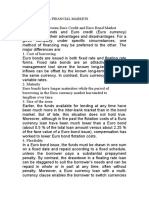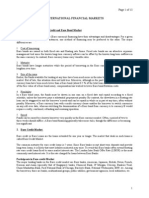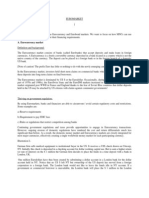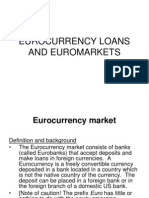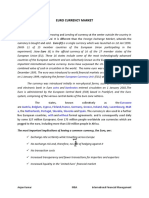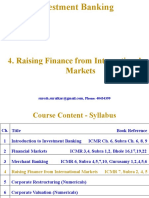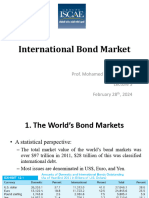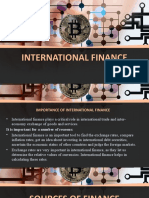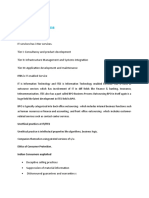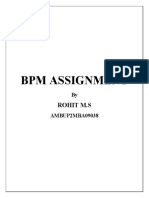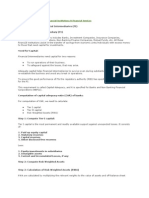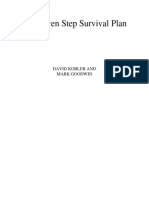11 International Financial Markets: Chapter Objectives
11 International Financial Markets: Chapter Objectives
Uploaded by
rohitkalidasCopyright:
Available Formats
11 International Financial Markets: Chapter Objectives
11 International Financial Markets: Chapter Objectives
Uploaded by
rohitkalidasOriginal Title
Copyright
Available Formats
Share this document
Did you find this document useful?
Is this content inappropriate?
Copyright:
Available Formats
11 International Financial Markets: Chapter Objectives
11 International Financial Markets: Chapter Objectives
Uploaded by
rohitkalidasCopyright:
Available Formats
11
International Financial
Markets
Chapter Objectives
1. To discuss issues relating to all aspects of the Eurocurrency market: creation of
Eurodollars, their uses, and Eurodollar instruments.
2. To explain three Euronote issue facilities: Euronotes, Eurocommercial paper, and
Euro-medium-term notes.
3. To explain major issues of the Eurocurrency interbank market: functions, risks, and
minimum standards of international banks.
4. To describe the differences in the role of corporate governance between the United
States and Japan.
5. To review the Asian currency Market.
6. To describe the international bond market.
7. To discuss the international equity market along with privatization.
International Financial Markets 133
Chapter Outline
I. I. Eurocurrency Markets
A. The eurocurrency markets is made up of banks that accept deposits and
make loans in foreign currencies outside the country of issue.
i. These deposits are known as eurocurrencies.
1. That is, US dollars deposited in London are called
Eurodollars, British pounds deposited in New York are
called Eurosterling, and Japanese yen deposited in London
are called Euroyen.
B. Because Eurodollars are the major form of eurocurrency, the term
“Eurodollar” frequently refers to the entire Eurocurrency market.
i. Eurodollars may be broadly defined as dollar-denominated
deposits in banks all over the world, excluding the United States.
1. These banks include foreign banks and US subsidiaries.
ii. Many experts narrowly define Eurodollars as dollar deposits in
Western Europe.
1. This distinguishes Eurodollars from petrodollars (in the
Middle East) and Asian dollars (in Hong Kong or
Singapore).
C. Eurocurrency markets serve a number of valuable purposes:
i. They are a convenient money market device for MNCs to hold
their excess liquidity.
ii. They are a major source of short-term loans to finance corporate
working capital needs and foreign trade.
iii. They are becoming a major source of long-term investment capital
for MNCs.
D. Eurodollars are created by the following partners jointly:
i. Public and private depositors by always keeping their money in
non-US banks on deposit.
ii. Banks by keeping none of their Eurodollar deposits in the form of
cash.
iii. Public and private borrowers who make it possible for the banks to
find Eurodollar loans.
E. Eurodollars cannot expand indefinitely, there are checks on expansion:
i. Public and private depositors may hold part of their Euordollar
deposits as liquid reserve.
ii. Banks may retain a part of their Eurodollar deposits as a liquid
reserve.
iii. Borrowers may convert the dollars borrowed into local currency.
F. European banks with Eurodollars use them in a variety of ways:
i. They may redeposit their Eurodollars in other European banks or
European branches of a US bank.
ii. They may make loans to non-bank users such as MNCs.
iii. They may transfer their dollars to Eurodollars in European
branches of a US bank.
International Financial Markets 134
G. A variety of parties are major borrowers of Eurodollars:
i. The heaviest borrowers are governments and commercial banks.
1. Many countries want Eurodollars to improve their
international reserves.
2. Many banks want Eurodollars to grant credit to exporters
and importers.
ii. Many of the non-bank private borrowers are companies engaged in
international operations.
H. There are two major types of Eurodollar market instruments: deposits and
loans.
i. Eurodollars deposits are either fixed time deposits or negotiable
certificates of deposits.
1. Time deposits are funds being placed in a bank for a fixed
maturity at a specified interest rate.
2. A certificate of deposit (CD) are formal negotiable receipts
for funds left with a bank for a specified period of time at a
fixed or floating rate of interest.
a. Its advantage over timed deposits is its liquidity.
ii. Eurodollars loans range from a minimum of $500,000 to $100
million, typically in multiples of $1 million. Maturities range from
30 days to a few years.
1. Short-term lending represents the major part of the
Eurodollar lending business.
2. Eurobanks also provide medium-term loans, either
revolving Eurodollar credits or Eurodollar term loans.
a. Revolving credit is a confirmed line of credit
beyond one year.
b. Term loan maturities range from three to seven
years.
iii. There are different interest rates for Eurodollar deposits and loans,
but forces of supply and demand determine both.
1. More specifically, the interest rates depend on the rate in a
corresponding home currency, spot and forward exchange
rate, domestic and Eurocurrency rates in other currencies,
and the inflation rate in various countries.
a. Interest rates on Eurodollar deposits are usually
higher than those on deposits in the US and interest
rates on Eurodollar loans are generally lower than
those on loans in the US.
2. Eurobanks operate on a narrower margin (in comparison to
US banks), but still make profit due to the following
differences:
a. Eurobanks, having no reserve requirements, can
lend a larger percentage of their deposits.
b. Eurobanks have very little or no regulatory expense.
International Financial Markets 135
c. Eurodollars are characterized by high volumes and
well known borrowers and this reduces the costs of
information gathering and credit analysis.
d. Many Eurodollar loans take place in tax-haven
countries.
e. Eurobanks are not forced to lend money to
borrowers at concessionary rates.
3. The lending rate is typically some fixed percentage above
the six-month London Interbank Offered Rate (LIBOR).
4. The LIBOR is the British Banker’s Association average of
interbank offered rates for dollar deposits in the London
market based on quotations at 16 major banks.
a. The LIBOR is an important international reference
rate.
b. Some imitators of the LIBOR are the Euro
Interbank Offered Rate (EIBOR), Kuwait Interbank
Offered Rate (KIBOR), Singapore Interbank
Offered Rate (SIBOR) and Madrid Interbank
Offered Rate (MIBOR).
iv. The lack of government controls on international capital flows
results in arbitrage between internal and external segments of the
market for dollar credit.
1. This arbitrage keeps the spread between internal and
external rates within a narrow margin.
I. Euronote Issue Facilities:
i. Euronotes issue facilities (EIFs) are a recent innovation in
nonblank short-term credits and are notes that are issued outside
the country in whose currency they are denominated.
ii. Euronotes are short-term debt instruments underwritten by a group
of international banks called a “facility.”
1. Euronotes typically have maturities from one to six months,
but many MNCS roll them over continually as a source of
medium-term financing.
2. Euronotes are sold at a discount from face value.
iii. Eurocommercial paper (ECP) are unsecured short-term promissory
notes sold by finance companies and certain industrial companies.
1. ECP are sold at a discount from face value.
iv. Euro-medium-term notes (EMNTs) are medium-term funds
guaranteed by financial institutions with short-term commitments
by investors.
1. The main advantage is that banks underwrite or guarantee
the funds for a period of five to seven years. If the
borrower cannot sell all or part of their notes, the banks will
then buy all or part of the notes.
International Financial Markets 136
a. This means that EMTNs provide a medium-source
of funds, without the obligation to pay the interest
on the debt when the funds are not needed.
J. Eurocurrency Interbank Market
i. The interbank market has over 1,000 banks from 50 different
countries.
1. 20 Major banks dominate the interbank market.
ii. Functions of the interbank market:
1. The interbank market is an efficient market system through
which funds move from banks in one country to banks in
other countries.
2. The interbank market gives banks on efficient mechanism
to buy or sell foreign-currency assets and liabilities of
different maturities in order to hedge their exposure to
interest-rate and foreign-exchange risks.
3. The interbank market is a convenient source of additional
loans when banks need to adjust their balance sheets either
domestically or internationally.
4. The interbank market help banks to sidestep regulations on
capital adequacy and interest rates prevalent in many
domestic banking markets.
iii. There are risks for participating banks:
1. Credit or default risk, i.e. the risk that the borrowing bank
may default on its loan.
2. Liquidity risk, i.e. the risk that other banks may withdraw
their interbank deposits suddenly forcing the bank to sell
off illiquid assets for less than their face value to meet the
deposit drain.
3. Sovereign risk, i.e. the risk that a foreign country may
prevent its banks from repaying interbank loans or deposits
received from banks in other countries.
4. Foreign exchange risk, i.e. the risk that a bank participant
in this market will gain or lose due to changes in exchange
rates.
5. Settlement risk, i.e. the risk of a breakdown or
nonsettlement on the major wire-transfer systems.
6. Additionally, regulators are concerned about the stability of
the market because:
a. Interbanks funds have no collateral.
b. Central banks regulations are inadequate.
i. Together these factors expose the market to
contagion, that is a condition where
problems at one bank affect other banks in
the market.
II. International Banks
International Financial Markets 137
A. International banks have some minimum standards for transactions with
each other.
i. The Basel Committee is a committee under the auspices of the
Bank for International Settlements -- a bank in Switzerland that
facilitates transactions among central banks.
ii. In 1988, the Basel Committee reached an agreement with the
central-bank governors of the Group of Ten countries to set
minimum standards for international bank cross-border activities.
1. Globally active banks have to maintain capital equal to at
least 8 percent of their risk-weighted assets.
a. The agreement was ineffective because the
regulatory measure of bank risk (risk-weighted
assets) differed significantly from actual bank risk.
2. A new capital adequacy framework was established in 1998
based on three pillars:
a. Minimum regulatory capital requirements that
expand on those in the 1988 accord.
b. Direct supervisory review of a bank’s capital
adequacy.
c. The increased use of market discipline through
public disclosure to encourage sound risk
management practices.
3. In 2003, a new Basel Capital accord was released for
comment.
a. The main change is in how the capital standard is
computed to consider certain risks.
B. The “Three Cs” of Central Banking.
i. Consultation: this involves not only exchange of information, but
also an explanation of current economic conditions and policies.
ii. Cooperation: for this “C,” countries retain full national
sovereignty, but decide voluntarily to allow the actions of other
countries to influence their decisions.
iii. Coordination: this involves individual central banks relinquishing
some or all decision-making powers to other countries or
international institutions.
C. The Role of Banks in Corporate Governance
i. The United States: A market based system of corporate
governance:
1. Legislation introduced after the Great Depression have
caused the fragmentation of financial institutions and
institutional portfolios.
2. This prevents corporate governance through large-block
shareholders.
3. US banks traditionally faced the following prohibitions:
a. US banks cannot own stock for their own account.
International Financial Markets 138
b. US banks cannot actively vote shares held in trust
for their bank clients.
c. US banks cannot make a market in equity securities.
d. US banks cannot engage in investment banks
activities.
4. Recently, some of these constraints have been relaxed.
a. Interstate banking was legalized in 1994.
b. Full interstate branch banking was legalized in
1997.
c. Securities firms, insurance companies, asset
managers, and US banks have been allowed to
freely enter each other’s businesses or merge since
2000.
d. Many expect the eventual creation of universal
banks or a bank where the financial corporation not
only sells a full scope of financial services, but also
owns significant equity stakes in institutional
investors.
ii. Japan: A bank-based system of corporate governance.
1. The bank-based system relies on concentrated ownership in
the hands of a main bank and/or the business partners for
both debt and equity capital.
2. This system in Japan stems in part from vast mutual-aid
network called Keiretsu.
a. Keiretsu is a Japanese word that stands for a
financially linked group of companies that play a
significant role in the country’s economy.
b. Keiretsu, usually with a main bank at the center,
form the backbone of corporate Japan.
3. Japanese banks can hold the borrowing company’s
common stock, and thus the main bank has access to
information about the company and a say in its
management.
4. Recent economic problems in Japan have changed the
country’s financial structures.
a. This includes reduced bank borrowing, more capital
market financing, the erosion of the main bank
power in corporate affairs, the reduction of cross-
shareholdings, and a weaker Keiretsu system.
III. The Asian Currency Market:
A. In 1968 an Asian version of the Eurodollar was started in commercial
banks in Singapore.
B. Since the US dollar accounts for most of the foreign currency transactions
in Singapore, the term “Asian dollar market” can be used to mean the
Asian currency market.
International Financial Markets 139
C. The Asian currency market when the monetary authority of Singapore
made the following incentives to foreign banks so that dollar accounts
could be held in Singapore:
i. The removal of an existing 40% tax on interest payments on
foreign currency deposits.
ii. The reduction of the tax rate on interest earned from offshore
loans.
iii. The abolition of stamp duties on CDs and bills of exchange.
iv. The abolition of the 20% reserve requirements for Asian Currency
Units (ACU).
1. ACU are a section within a bank which has authority and
separate accountability for Asian currency market
operations.
D. ACUs are required to operate under the following rules:
i. They can accept foreign currency deposits from foreigners without
the prior approval of the authorities.
ii. They can lend to individuals or companies outside the British
Commonwealth countries without the prior approval of the
authorities.
iii. They cannot lend to residents of Singapore or British
Commonwealth countries without the prior approval of the
authorities.
E. Approximately 150 banks or other financial institutions have licenses to
operate as ACUs.
F. The Asian currency market is primarily an interbank market and interest
rates are primarily based on either SIBOR or LIBOR.
IV. The International Bond Market
A. International bonds are those bonds that are initially sold outside the
country of the borrower.
i. They consist of foreign bonds, Eurobonds, and global bonds.
ii. An important issue is currency, and the currency of issue is not
necessarily the same as the country of issue.
B. Foreign bonds are bonds sold in a particular national market by a foreign
borrower.
i. They are underwritten by a syndicate of brokers from that country.
ii. They are denominated in the currency of that country.
iii. That country’s national or domestic authorities regulate them.
iv. The first foreign bond was issued in 1958.
C. Eurobonds are bonds underwritten by an international syndicate of brokers
and sold simultaneously in many countries other than the country of the
issuing entity.
i. Eurobonds are issued outside the country in whose currency they
are denominated.
ii. The Eurobond market is almost entirely free of regulation, but is
self-regulated by the Association of International Bond Dealers.
iii. The first Eurobond was issued in 1963.
International Financial Markets 140
iv. There a number of differences between the Eurodollar market and
Eurobond market:
1. The Eurodollar market is an international money market,
but the Eurobond market is an international capital market.
2. The Eurodollar market is a financial intermediation market;
the Eurobond market is a direct market.
a. This means that in the Eurodollar market major
world banks act as intermediaries while in the
Eurobond market Eurobonds are issued directly by
the final borrowers.
v. The Eurobond market is attractive for a variety of reasons:
1. Interest income earned is not subject to withholding tax.
2. The market is relatively free from national regulations.
D. Global bonds are bonds sold inside as well as outside the country in whose
currency they are denominated.
i. The World Bank issued the first global bonds in 1989 and still
remains the leading issuer of global bonds.
ii. By allowing issuers to solicit demand from a variety of markets
and to offer greater liquidity to investors, global bonds have the
potential to reduce borrowing costs.
E. The amount of outstanding international debt securities reached $8,344
billion in the 3rd quarter of 2002.
i. Eurobonds account for 70% of the market.
ii. Foreign bonds and global bonds account for 30%.
iii. Industrial countries account for 85% of the market.
iv. Developing countries account for 15%.
F. International bonds are denominated in a variety of currencies.
i. In the 3rd quarter of 2002, 48% of the market was denominated in
US dollars.
ii. 36% was denominated in Euros.
iii. 16% was denominated in either other single currencies or
composite units of currencies.
iv. Currency-option bonds are bonds where holders are allowed to
receive their interest income in the currency of their option from
two or three predetermined currencies.
v. Currency cocktail bonds are bonds denominated in a standard
currency basket.
G. Types of international bonds:
i. Straight bonds are bonds with fixed maturities and interest rate.
1. They are repaid by amortization or in a lump sum at
maturity date.
a. Amortization refers to the retirement of long-term
debt by making a set of equal periodic payments
including both interest and principal.
2. They are technically unsecured, debenture bonds because
they are not secured by any property of the borrower.
International Financial Markets 141
ii. Floating-rate notes or bonds have a rate of return that is adjusted at
regular intervals to reflect changes in short-term market rates.
1. Most floating-rate notes are issued in dollars and in
denominations of $1,000 each.
2. They typically carry a margin of ¼ percent above LIBOR.
iii. Convertible bonds are convertible into parent common stock.
1. The conversion price is usually fixed at a certain premium
above the market price of the common stock on the date of
the bond issue.
2. Conversion can be completed any time before the
conversion privilege expires.
3. The convertible provision is designed to increase the
marketability of fixed-rate Eurobonds by providing
investors with a steady income and an opportunity to
participate in rising stock prices.
iv. Some bonds come with warrants.
1. Warrants are an option to buy a state number of common
shares at a stated price during a prescribed period.
2. Warrants pay no dividends, have no voting rights, and
become worthless at expiration unless the common stock
price exceeds the exercise price.
v. There a variety of other bonds types.
1. The major other type of bond is zero-coupon bonds. These
are bonds that provide all of the cash payment (interest and
principal) when they mature.
a. They do not pay interest but are sold at a deep
discount from their face value.
b. The return to the investor is the excess of the face
value over the market price.
c. The advantage to investors is that there is
immediate cash inflow without any periodic interest
to pay.
d. The advantage to the issuing company is in the form
of a tax reduction.
vi. Percentage breakdown of the total bond market by instrument (in
2001):
1. 71% straight bonds.
2. 25% floating-rate bonds.
3. 4% convertible bonds.
V. The International Equity Market
A. The international equity grew in the 1990s as companies increasingly
turned to it as a source of funds for global expansion.
i. The primary market is a market where the sale of common stock
by corporations to initial investors occurs.
ii. The secondary market is a market where the previously issued
common stock is traded between investors.
International Financial Markets 142
B. There a three major new trends in stock markets around the world:
i. Stock market alliances, i.e. the alignment of some of the 150 stock
exchanges in the world.
1. For example, markets in Paris, Amsterdam, and Brussels
have formed Euronext.
2. Stock markets consolidate or align due to the growing
speed and power of telecommunication links, big and small
investors’ interest in stocks from all parts of the world, and
the fear of being left behind.
3. These same factors have caused stock markets to become
traded on different stock exchanges.
ii. Crosslisting, i.e. the listing of one company’s stock on different
exchanges around the world. MNCs crosslist to:
1. Allow foreign investors to buy their shares in their home
market.
2. Increase the share price by taking advantage of the home
country’s rules and regulations.
3. Provide another market to support a new issuance in the
foreign market.
4. Establish a presence in that country in the instance that it
wishes to conduct business in that country.
5. Increase its visibility to its customers, creditors, suppliers,
and host government.
6. Compensate local management and employees in the
foreign affiliates.
iii. Stock market concentration, i.e. the integration of stock markets.
1. Integration has been especially prevalent in Europe since
the introduction of the Euro.
2. Concentration is not an “Eu-phenonenon,” but instead is a
global tend toward a single global market for certain
instruments.
a. The three largest stock markets accounted for 60%
of the total market capitalization in 1995 and 2001.
This indicates a trend toward concentration of the
world stock markets.
iv. Privatization is a situation in which government-owned assets are
sold to private individuals or groups.
1. Many developing countries have gone through privatization
in recent years.
2. Privatization may facilitate a switch from investment in
bonds to an investment in equities.
3. Governments privatize for a variety of reasons:
a. To assist the development of capital markets by
increasing market capitalization and liquidity.
b. To widen share ownership and to create a
shareholder culture in the population.
International Financial Markets 143
c. To raise money for the government.
d. To make changes in governance structure by
replacing public sector decision-making with
private sector control.
e. Enabling the government to use their resources
more efficiently.
4. Governments privatize in a variety of ways:
a. A government sells state-owned companies directly
to a group of ultimate investors.
b. A government divests itself of a company it owns
through public offerings of equity in the primary
market.
c. A government may sell residual stocks of partly
privatized companies in the secondary market.
d. Other privatization methods include leasing, joint
ventures, management contracts, and concessions.
5. Successful privatization involves three elements:
a. The government needs a political agreement to sell
all or part of a company it owns.
b. The company should the potential to transform
itself into a profit-making entity rather than a
government-subsidized burden.
c. The government has to find underwriters who will
distribute and market the shares domestically and
internationally.
C. Long-term capital flows to developing countries.
i. Long-term capital flows to developing countries have declined
since 1998.
1. This is mainly due to the Asian financial crisis of 1997 and
the slowdown of the global economy.
2. The share of emerging markets in global capital market
financing fell to 3% in 2002 compared to 6.4% in 1998 and
11 % in 1997.
ii. The pattern of private flows to developing countries is shifting –
debt down, equity up. The World Bank highlighted three aspects
of this shift:
1. The shift is partly driven by investor preferences.
2. The shift is privately driven by the preferences of
developing country policymakers.
3. The shift is a positive development.
Key Terms and Concepts
Eurocurrency Market consists of banks that accept deposits and make loans in foreign
currencies outside the country of issue.
International Financial Markets 144
Eurodollar could be broadly defined as dollar-denominated deposits in banks all over the
world except the United States.
Certificate of deposit (CD) is a negotiable instrument issued by a bank.
Revolving Eurodollar Credit is a confirmed line of credit beyond one year.
London Interbank Offered Rate (LIBOR) is British Banker's Association average of
interbank offered rates for dollar deposits in the London market based on quotations at 16
major banks.
Euronote Issue Facilities (EIF), a recent innovation in nonbank short-term credits, are
notes issued outside the country in whose currency they are denominated.
Euronotes are short-term debt instruments underwritten by a group of international
banks called a "facility".
Euro Commercial Paper (ECP), like domestic paper, are unsecured short-term
promissory notes sold by finance companies and certain industrial companies.
Euro-Medium-Term Notes (EMTNs) are medium-term funds guaranteed by financial
institutions with the short-term commitment by investors.
Contagion the process where problems at one bank spread to affect other banks in the
market thereby threatening the market’s stability and its function.
Bank for International Settlements is a bank in Switzerland that facilitates transactions
among central banks.
Federal Funds are reserves traded among US commercial banks for overnight use.
Keirutsu is a Japanese word that stands for a financially linked group of companies that
play a significant role in the country's economy.
Asian Currency Units (ACUs) is a section within a bank that has authority and separate
accountability for Asian currency market operations.
International Capital Market consists of the international bond market and the
international equity market.
International Bonds are those bonds that are initially sold outside the country of the
borrower.
Foreign Bonds are bonds sold in a particular national market by a foreign borrower,
underwritten by a syndicate of brokers from that country, and denominated in the
currency of that country.
International Financial Markets 145
Eurobonds are bonds underwritten by an international syndicate of brokers and sold
simultaneously in many countries other than the country of the issuing entity.
Global Bonds are bonds sold inside as well as outside the country in whose currency
they are denominated.
Currency-Option Bonds are bonds whose holders are allowed to receive their interest
income in the currency of their option from among two or three predetermined currencies
at a predetermined exchange rate.
Currency-Cocktail Bonds are those bonds denominated in a standard "currency basket"
of several different currencies.
Amortization Method refers to the retirement of a long-term debt by making a set of
equal periodic payments.
Warrant is an option to buy a stated number of common shares at a stated price during a
prescribed period.
Zero-coupon Bonds provide all of the cash payment (interest and principal) when they
mature.
Primary Market is a market where the sale of a new common stock by corporations to
initial investors occurs.
Secondary Market is a market where the previously issued common stock is traded
between investors.
Privatization is a situation in which government-owned assets are sold to private
individuals or groups.
Multiple Choice Questions
1. A dollar denominated deposit made in a bank in _____ does not give rise to
Eurodollars.
A. UK
B. France
C. Japan
D. the U.S.
E. Saudi Arabia
2. Which of the following does not contribute to the efficiency of the Eurodollar
mechanism?
A. The U.S. imposed no restrictions on nonresident transactions
International Financial Markets 146
B. Foreign entities are free to transact with the U.S. banks
C. European banks offer competitive rates for Eurodollar deposits and loans
D. No reserve requirements for Eurodollar time deposits
E. None of the above
3. The risk that a foreign country may prevent its banks from repaying interbank loans
or deposits is known as _____ risk.
A. Credit
B. Liquidity
C. Sovereign
D. Foreign Exchange
E. Settlement
4. Which of the following is not a risk faced by participating banks in the interbank
market?
A. Credit risk
B. Stability risk
C. Foreign exchange rate risk
D. Sovereign
E. Settlement
5. A certificate of deposit has the following features:
A. A negotiable instrument
B. Issued by a bank
C. A time deposit
D. A and B
E. A, B and C
6. Which of the following is not true of Eurodollar loans:
A. They range from a minimum of $500,000 to $100 million.
B. The majority of their business is in short-term lending.
C. The two major forms of medium-term Eurodollar loans are Eurodollar credits
and Eurodollar term loans.
D. The primary borrowers are companies in developing countries.
E. Maturities range from 30 days to a few years.
7. Which of the following does not exist?
A. LIBOR
B. KIBOR
C. SIBOR
D. MIBOR
E. none of the above
8. Which of the following does not contribute to the development of the Asian currency
market in Singapore?
A. Asian dollar deposits would attract other deposits
International Financial Markets 147
B. They will increase banking activities
C. They will increase income from financial services
D. The existence of foreign deposits and foreign banks in Singapore will make it
politically unstable
E. Singapore is a logical center
9. The Bank for International Settlements is a bank in _____ which facilitates
transactions among central banks.
A. The United States
B. Japan
C. Germany
D. The United Kingdom
E. Switzerland
10. Interest rates on Eurodollar deposits may be higher than the rates on deposits in the
U.S. because _____.
A. Eurobanks are keen on attracting dollar denominated deposits
B. Eurodollar deposits are free of regulations
C. Eurobanks are free of reserve requirements
D. A and B
E. A, B and C
11. Which of the following does not describe the qualities of a foreign bond?
A. Foreign bonds are sold in a particular country by a foreign borrower
B. They are underwritten by a syndicate of members from the foreign country
C. They are denominated in the currency of the borrower's country
D. A and B
E. A, B and C
12. "Three Cs" of central banking include _____.
A. Coordination
B. Coordination
C. Consultation
D. A and B
E. A, B and C
13. Which of the following is a reason why central banks might tend to change their
interest rate targets in a similar fashion:
A. Countries react similarly to common shocks.
B. Countries may desire to maintain stable exchange rates.
C. Economic conditions in one country affect those in other countries through trade
and capital flows.
D. A and B
E. A, B, and C
14. The holders of _____ bonds are allowed to receive their interest income in the
International Financial Markets 148
currency of their choice.
A. Currency
B. Currency-cocktail
C. Fixed-rate
D. Equity-related
E. Currency-option
15. Which of the following is not a use of Eurodollar?
A. European banks may redeposit their Eurodollars
B. They make loans to multinational companies
C. Many countries use Eurodollars to improve their international reserves
D. None of the above
E. A, B and C
16. Interest rates on Eurodollar loans may be lower than those on loans in the U.S.
because _____.
A. Cost of information collection is low
B. Eurobanks can lend a larger percentage of their deposits
C. Eurobanks have no regulatory expenses
D. All of the above
E. None of the above
17. Repayment by amortization is made possible by _____.
A. Fixed maturities
B. Fixed rate of interest
C. A set of equal periodic payments
D. A and B
E. A, B and C
18. Banks are the main source of capital in Japan because:
A. The Bank of Japan provides major industries with long-term loans at favorable
rates through commercial banks.
B. Japanese banks have ample funds for loan because of the country’s high savings
rates and huge trade surpluses.
C. There are a few restrictions on commercial banking in Japan.
D. The use of keiretsu in Japan increases the access to large amounts of debt
E. All of the above.
19. Which of the following organizations have proposed changes in the global corporate
governance system:
A. The New York Stock Exchange
B. The Securities Industry Association
C. The Sarbanes-Oxley Act
D. The US Chamber of Commerce
E. The Business Roundtable
International Financial Markets 149
20. Which of the following is not a type of international bonds?
A. Straight bonds
B. Convertible bonds
C. Floating-rate bonds
D. Zero-coupon bonds
E. None of the above
21. An option to buy a stated number of common shares at a stated price during a
prescribed period is known as a _____.
A. Forward
B. Warrant
C. Future
D. Coupon
E. Voucher
22. _____ risk is the risk of a breakdown on the major wire-transfer system.
A. Liquidity
B. Foreign exchange
C. Settlement
D. Sovereign
E. Default
23. Eurobonds are long-term obligations denominated in outside the country of issue.
A. Swiss franc
B. US dollars
C. Japanese yen
D. British pounds
E. all of the above
24. Eurodollars can be created in _____.
A. Europe
B. Asia
C. Latin America
D. Africa
E. All of the above
25. The main characteristics of fixed rate bonds do not include _____.
A. A fixed interest rate
B. A fixed maturity
C. Unsecured debentures
D. No interest payment until maturity
E. A, B, and C
26. If the U.S. government imposes additional taxes on interest paid on U.S. bank
deposits, the likely effect of this regulation is to _____.
A. Expand the Eurodollar market
International Financial Markets 150
B. Reduce the Eurodollar market
C. Have no impact on the size of the Eurodollar market
D. Increase U.S. bank deposits
E. None of the above
27. Euronote issue facilities consist of _____.
A. Euronotes
B. Eurocommercial paper
C. Euro-medium-term notes
D. A and B
E. A, B, and C
28. Which of the following is not true of the make-up of international bond market as of
the
3rd quarter of 2002:
A. Industrial countries are the largest participants in the market.
B. Eurobonds are the most commonly purchased instrument.
C. Slightly less than 50% of the bond issues are denominated in US dollars.
D. Slightly more than 50% of the bond issues are denominated in euros.
E. The amount of international debt securities outstanding was at the highest point
to date.
29. The three features of the shift from by developing countries from debt to equity are:
A. The shift is privately driven by the preferences of developing country
policymakers.
B. The shift is a negative development.
C. The shift is partly driven by investor preferences.
D. A and C
E. A, B, and C
Answers
Multiple Choice Questions
1. E 11. D 21. B
2. E 12. E 22. C
3. C 13. E 23. E
4. B 14. E 24. E
5. E 15. D 25. D
6. D 16. D 26. A
7. E 17. E 27. E
8. D 18. E 28. A
9. E 19. C 29. D
10. E 20. E
International Financial Markets 151
You might also like
- Register of Cash in Bank and Other Related Financial Transactions100% (1)Register of Cash in Bank and Other Related Financial Transactions2 pages
- Bulacan State University: College of Business Administration100% (1)Bulacan State University: College of Business Administration13 pages
- 16-F-324-Eurocurrency Markets & Syndicated Credits PDFNo ratings yet16-F-324-Eurocurrency Markets & Syndicated Credits PDF22 pages
- Chapter 1 - International Banking & Money MarketNo ratings yetChapter 1 - International Banking & Money Market21 pages
- Financial Structure and International Debt: Group MembersNo ratings yetFinancial Structure and International Debt: Group Members29 pages
- Multinational Financial Management: Alan Shapiro 7 Edition J.Wiley & SonsNo ratings yetMultinational Financial Management: Alan Shapiro 7 Edition J.Wiley & Sons18 pages
- Presented By:-Sumit Singal MBA-I (3129)No ratings yetPresented By:-Sumit Singal MBA-I (3129)34 pages
- Lecture Notes - Sourcing Debt Globally - Student Version - Oct 2023No ratings yetLecture Notes - Sourcing Debt Globally - Student Version - Oct 202322 pages
- Eurocurrency Market: Submitted By: Group 3No ratings yetEurocurrency Market: Submitted By: Group 319 pages
- International Financial Markets: Chapter ObjectivesNo ratings yetInternational Financial Markets: Chapter Objectives21 pages
- Module 8. International Financial Market and Innovations ObjectivesNo ratings yetModule 8. International Financial Market and Innovations Objectives9 pages
- Euro Currency Markets: Financial ManagementNo ratings yetEuro Currency Markets: Financial Management3 pages
- Raising Finance From International MarketsNo ratings yetRaising Finance From International Markets55 pages
- Financial Market Debt Primary Market Securities Secondary Market BondsNo ratings yetFinancial Market Debt Primary Market Securities Secondary Market Bonds18 pages
- Eurocurrency Market: Features of The Euro Currency Market0% (1)Eurocurrency Market: Features of The Euro Currency Market6 pages
- Euro Currency Market and Its Instruments: Presentation byNo ratings yetEuro Currency Market and Its Instruments: Presentation by21 pages
- Health Heals' Case Based Test Time 2 Sessions - Marks 60: Read The Case and Answer The FollowingNo ratings yetHealth Heals' Case Based Test Time 2 Sessions - Marks 60: Read The Case and Answer The Following1 page
- Shrikhande International Finance Fall 2010 Problem Set 1: NswerNo ratings yetShrikhande International Finance Fall 2010 Problem Set 1: Nswer7 pages
- Aaoifi Governance Standards: Sharia Disclosure and Financial Performance For Islamic BanksNo ratings yetAaoifi Governance Standards: Sharia Disclosure and Financial Performance For Islamic Banks19 pages
- The Industry Handbook: The Banking Industry: Home Dictionary Articles Tutorials Exam Prep Forex Markets SimulaNo ratings yetThe Industry Handbook: The Banking Industry: Home Dictionary Articles Tutorials Exam Prep Forex Markets Simula5 pages
- Đề Trường Thpt Chuyên Lê Quý Đôn - Đà Nẵng - Live Chữa 24012024No ratings yetĐề Trường Thpt Chuyên Lê Quý Đôn - Đà Nẵng - Live Chữa 240120246 pages
- IBPS PO Model Paper Indian Overseas Bank Probationary Officer Exam Previous Year Question Paper100% (1)IBPS PO Model Paper Indian Overseas Bank Probationary Officer Exam Previous Year Question Paper62 pages
- Focusing On Customer Experience - Steven RamirezNo ratings yetFocusing On Customer Experience - Steven Ramirez34 pages
- Financial Information System: Shaira Karissa J. Cipriano Catherine Joy NayalNo ratings yetFinancial Information System: Shaira Karissa J. Cipriano Catherine Joy Nayal20 pages
- Refund Request For International StudentsNo ratings yetRefund Request For International Students2 pages
- Consolidated Balance Sheet Consolidated Balance SheetNo ratings yetConsolidated Balance Sheet Consolidated Balance Sheet12 pages
- Register of Cash in Bank and Other Related Financial TransactionsRegister of Cash in Bank and Other Related Financial Transactions
- Bulacan State University: College of Business AdministrationBulacan State University: College of Business Administration
- 16-F-324-Eurocurrency Markets & Syndicated Credits PDF16-F-324-Eurocurrency Markets & Syndicated Credits PDF
- Financial Structure and International Debt: Group MembersFinancial Structure and International Debt: Group Members
- Multinational Financial Management: Alan Shapiro 7 Edition J.Wiley & SonsMultinational Financial Management: Alan Shapiro 7 Edition J.Wiley & Sons
- Lecture Notes - Sourcing Debt Globally - Student Version - Oct 2023Lecture Notes - Sourcing Debt Globally - Student Version - Oct 2023
- International Financial Markets: Chapter ObjectivesInternational Financial Markets: Chapter Objectives
- Module 8. International Financial Market and Innovations ObjectivesModule 8. International Financial Market and Innovations Objectives
- Financial Market Debt Primary Market Securities Secondary Market BondsFinancial Market Debt Primary Market Securities Secondary Market Bonds
- Eurocurrency Market: Features of The Euro Currency MarketEurocurrency Market: Features of The Euro Currency Market
- Euro Currency Market and Its Instruments: Presentation byEuro Currency Market and Its Instruments: Presentation by
- Summary of Marc Levinson's Guide to Financial MarketsFrom EverandSummary of Marc Levinson's Guide to Financial Markets
- Summary of John Goddard & John O. S. Wilson's BankingFrom EverandSummary of John Goddard & John O. S. Wilson's Banking
- Health Heals' Case Based Test Time 2 Sessions - Marks 60: Read The Case and Answer The FollowingHealth Heals' Case Based Test Time 2 Sessions - Marks 60: Read The Case and Answer The Following
- Shrikhande International Finance Fall 2010 Problem Set 1: NswerShrikhande International Finance Fall 2010 Problem Set 1: Nswer
- Aaoifi Governance Standards: Sharia Disclosure and Financial Performance For Islamic BanksAaoifi Governance Standards: Sharia Disclosure and Financial Performance For Islamic Banks
- The Industry Handbook: The Banking Industry: Home Dictionary Articles Tutorials Exam Prep Forex Markets SimulaThe Industry Handbook: The Banking Industry: Home Dictionary Articles Tutorials Exam Prep Forex Markets Simula
- Đề Trường Thpt Chuyên Lê Quý Đôn - Đà Nẵng - Live Chữa 24012024Đề Trường Thpt Chuyên Lê Quý Đôn - Đà Nẵng - Live Chữa 24012024
- IBPS PO Model Paper Indian Overseas Bank Probationary Officer Exam Previous Year Question PaperIBPS PO Model Paper Indian Overseas Bank Probationary Officer Exam Previous Year Question Paper
- Financial Information System: Shaira Karissa J. Cipriano Catherine Joy NayalFinancial Information System: Shaira Karissa J. Cipriano Catherine Joy Nayal
- Consolidated Balance Sheet Consolidated Balance SheetConsolidated Balance Sheet Consolidated Balance Sheet




